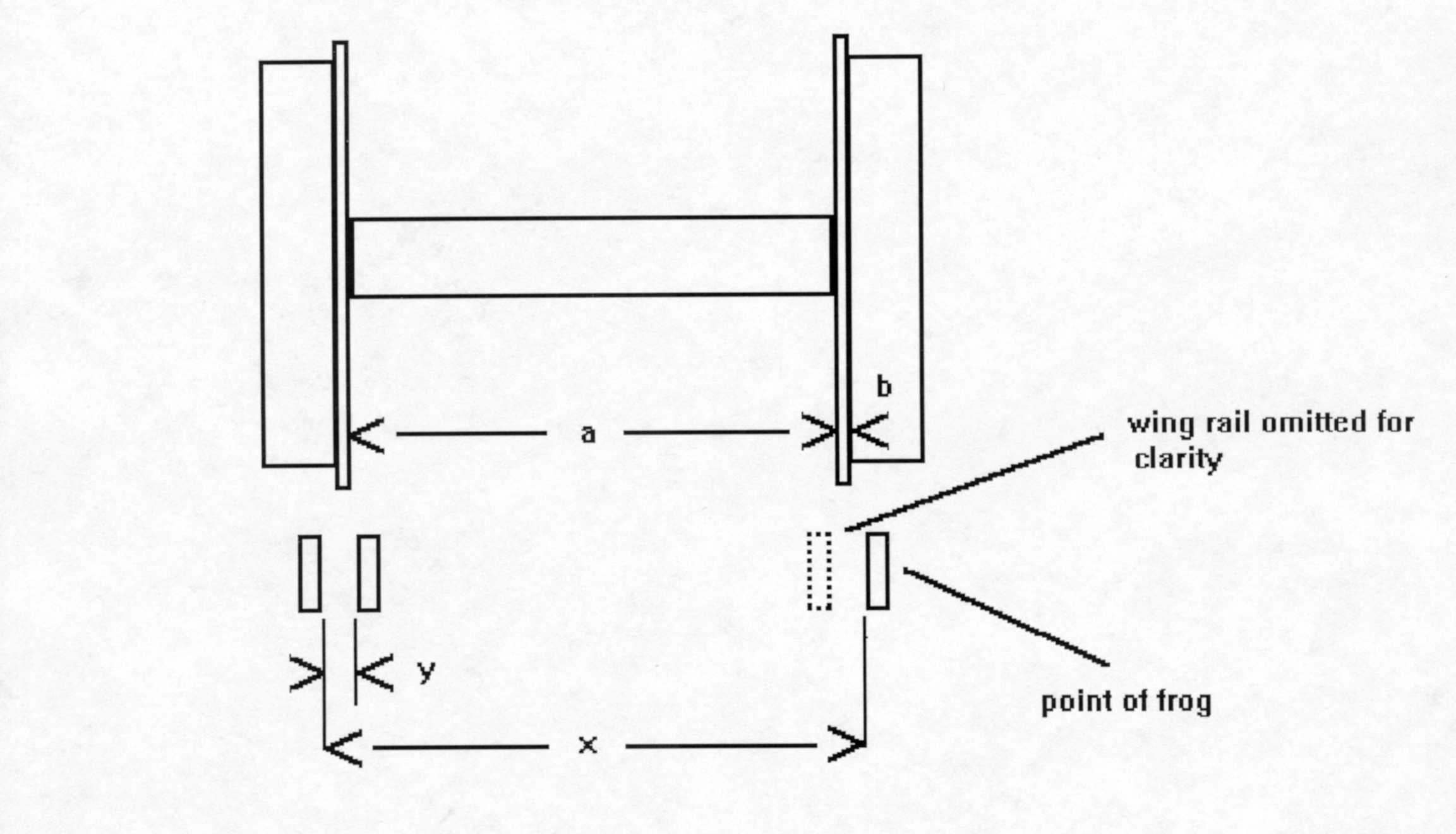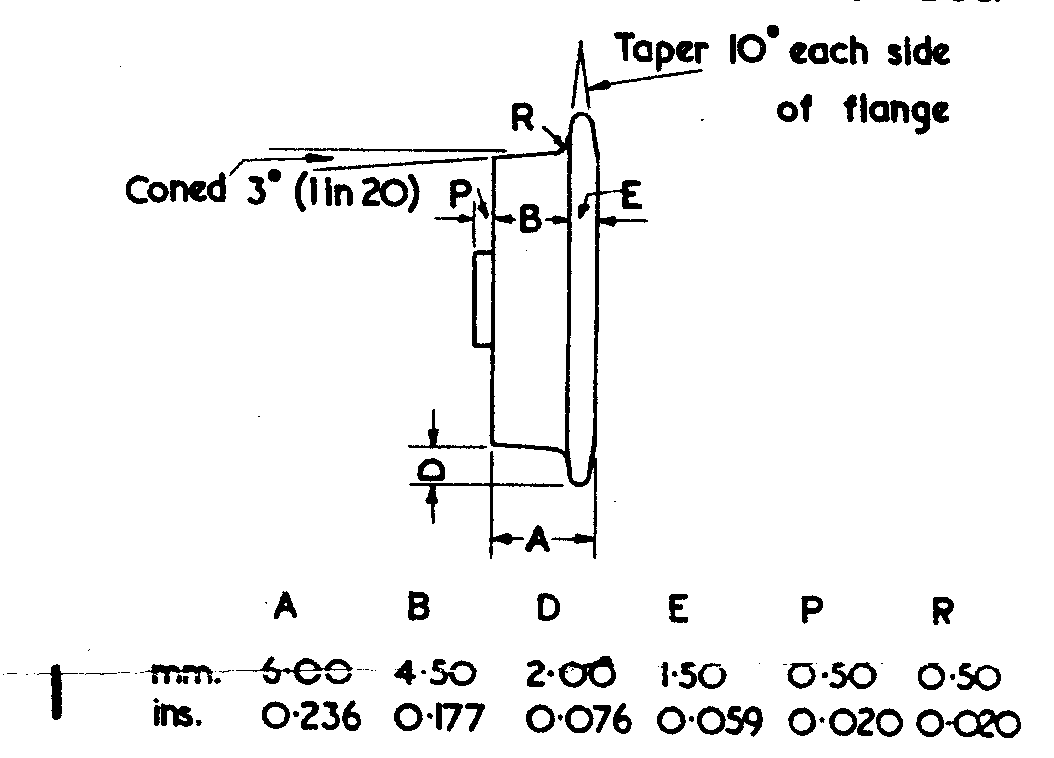Standard Track Dimensions (32mm)
by Sam Evans.
11th March 2001
Also available: Standard track dimensions for 45mm gauge
Track & wheel standards for 32mm gauge in the garden
Unfortunately the issue of standards is often misunderstood, with great emphasis placed on the back to back (btb) dimension of a wheelset and little else. When speaking of standards there are five absolutely crucial dimensions to consider. For wheelsets there are the btb and the flange thickness. For track, the gauge, the flangeway width, and the dimension over the check rail faces.
The most important relationship is that which prevents any part of the wheel flange from striking the point of the frog. Generally a train running through a point in a trailing direction will not experience difficulty unless the btb is tight on the check rails. Running through a facing point, particularly on a non-tangential road, is a different matter. The greater the interference (the amount by which incorrect dimensions will allow the flange to strike the frog nose or point) the greater the potential problem. At worst the train will 'split the point' i.e. it will try to run up the wrong side of the point from which it is set, or the flange striking the frog will flip the wheel up and derail it. This latter problem does not require that large an interference particularly if the train is running fast, and/or the stock is light in weight. Propelling stock through pointwork when shunting is also likely to show up interference at the frog.
Hopefully what follows will be of help.

| Standards(links to sources) |
Wheel a + b
|
Track x - y
|
Compatibility
|
Notes |
|
Gauge O Guild current Coarse
|
29.5 (28 + 1.5)
|
29.8 (32 - 2.2)
0.3mm clearance |
With Unified but little room (.0.05mm) for error.
With BRMSB coarse |
FD 1.5mm |
| BRMSB Coarse 1950 |
29.5 (28 + 1.5)
|
29.5 (32 - 2.5)
|
Not with Unified. At the time it was recommended that the btb
of coarse wheeled stock was opened our to 28.5mm. Further more it
was recommended that in order to run on BOTH Unified and Coarse track that
coarse wheels had their flanges thinned to 1mm
With Ga 0 Guild current coarse |
FD 1.5mm |
| Merioneth Railway Society (16mm finescale) |
29 (28 + 1.0)
|
29.5 (32 - 2.5)
0.5mm clearance |
Compatible with BMSRB 1950 standard and later GOG coarse standard. Possibly prone to dropping at crossing to latter standards if it is not accurately made. | FD 1.0mm |
| BRMSB 'Unified' 1951 |
29.75 (28.5 + 1.25)
|
30 (32 - 2.0)
[30.4 (32-1.6)] Note: Flangeway standard varies from 2mm min at 3'3" radius to 1.6mm min at 5' radius and over] Note also that the quoted figure is 30mm in all cases. |
With current GOG (just).
Not with BRMSB 1950 standard |
FD 1.5mm |
| Tenmille 32mm wheelsets |
30 (28.5 + 1.5)
|
-
|
With Unified (just)
Not compatible with any of others above, though interference is at minimum (0.2mm) with GOG current |
FD 2.0mm |
| Tinplate |
(27.0 + ?)
(27.5 + ?) |
-
|
-
|
-
|
| GIMRA Flangeway |
-
|
29.0 (32 - 3)
|
Not compatible with wheelsets of any of above. Interference at frog potentially 0.5-0.75mm, with Tenmille wheelsets, 1.0mm | See below for resolution to this problem. |
Note that the wheelset dimension should be the same as or slightly less than the track dimension. If the figures are the same there is less tolerance of errors in either track or wheelset.
Note also that flange depth is also a limiting factor particularly with respect to the depth of the crossing at the frog on moulded mass-produced points intended for track power. The greater the disparity here the greater the risk of electrical discontinuity, particularly if the points are of the 'dead frog' variety. Flange depth also limits the minimum rail code used, though the finer the flange depth the closer one is to having to consider fitting compensation/springing to cope with track irregularities which seem part & parcel of the outdoor environment. I personally consider a flange depth of 2mm to be a good median between 3mm and 1.5 or finer.
The other factor in basic compatibility is whether the back to backs
will clear the check rails.
|
Standards
|
Back-to-back
|
Over guard rails
x-2y |
Compatibility
Wheels to track |
Notes
|
| GOG current |
28
|
27.6 [0.4mm tolerance]
|
Not Unified (see note in above table) |
-
|
| BRMSB 1950 and Merioneth Society |
28
|
27 [1mm tolerance]
|
Not Unified (see note on above table | Large tolerance here bought at expense of no tolerance in the frog (see table above) |
| BRMSB Unified 1951 |
28.5
|
28 [0.5mm tolerance]
28.8 [intolerant] Above by summation assuming all the point flangeways to be equal. Quoted figures in the same order are
|
Ok with all ON THIS TABLE but see above. Also appears can be
intolerant within the standard.
Interestingly if these quoted figures were practical one does wonder why not stick to a 2mm flangeway at points (27.6mm fig). This would have done away with the need to open out older stock to 28.5 btb. |
-
|
| Tinplate |
27
to 27.5 |
-
|
More or less compatible with BRMSB 1950
Not with any other. |
-
|
| GIMRA flangeways
(3mm) |
-
|
26
|
Will take any wheelset ON THIS TABLE. But see above table | Any compatibility here is gained at the expense of potential interference at frog. |
The back-to-back measurement must be greater than the over guard (check)
rails dimension.
Observations:
Note that in all these standards there are maxima or minima, but you 'may be robbing Peter to pay Paul'. A major failing of all standards I have come a cross so far, regardless of gauge, is that while Maxima OR Minima are quoted for figures, there is no indication of tolerances. As the standards are largely for the benefit of the manufacturers it seems odd that acceptable room for manufacturing error is not clearly stated. Ideally there should be stated for each dimension a Maximum AND Minimum. After all the name of the game is to stick as closely/accurately as possible to the standard dimension accepting that there will be some SLIGHT variation.
The 'Unified' standard of 1951 was a compromise after the setting of the 1950 fine and coarse standards. It was an effort to provide standards on which both Coarse and Fine could run. From the notes you will see that it was a) something of a dog's breakfast, and b) that the Coarse 'scale' folk had to do rather more compromising than the Fine 'scale' folk. Needless to say the Unified standard is now something of a folk memory.
The 1950 coarse standard survived unaltered until it was realised that the track and wheel dimensions described in the top table, being the same, left little room for error. The flangeway was reduced in width by 0.3mm by the GOG in the late 80's to resolve this problem. This has reduced the btb over check rail tolerance from 1mm to 0.4mm but this seems to work.
I suspect that a fair bit of 32mm gauge pointwork has been built using
check rail chairs intended for Ga I (3mm flangeway). This is problematic,
especially for wheelsets of 28.5mm btb when there can be up to 1mm interference
between wheel flange and frog. A solution is to cut through
the check rail chairs to release the check rails on the OPPOSITE side to
the frog. Clean the check rails up and solder them to drilled brass
tabs (most model shops have K metal stands or similar with suitable brass
strip) and pin them back in position using a gauge to give a flangeway
of 2.2mm. DO NOT BE TEMPTED TO REDUCE THE FLANGEWAY FURTHER, or 28mm
btb wheelsets will start to have trouble. This is the same method
by which Brandbright point kits now fix their check rails. Do not
worry about the wing rail flangeways next to the frog.
Railwood do a roller gauge but do ask what the flangeway dimension is before
buying.
My Conclusions.
The whole issue could be put to bed if the 16mm
Association FIRMLY recommended to manufacturers that the current
Gauge 0 Guild coarse standard be followed, with the exception of the wheel
profile. For the wheel profile I suggest
the use of the GIMRA standard for three reasons.
- Providing it is set at 28mm btb its flange width is the same as the GOG standard so there should be no interference at the frog.
- The flange depth is slightly greater at 2mm; some may see this as an advantage and it should present no problems with most trackwork.
- The greater wheel width means a greater tolerance of any errors at the crossing.
- Last, but by no means least, as most manufacturers also build for 45mm ga they will not need the expense of different tooling for 32 & 45mm ga wheels.
GIMRA WHEEL PROFILE

And finally: All information
in this article
is provided in good faith. Please note that the figures are based
on the latest information that I have managed to get so far. (2004)